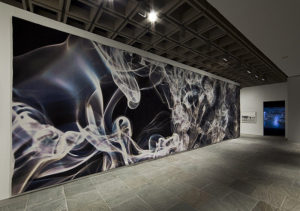
Everything’s relative, so it can said that this year’s Whitney Biennial is easier on the senses than many in the past. It’s smaller (only 55 artists), quieter, and less frenetic than many of its predecessors. You can get through it without feeling assaulted or insulted (well, almost). There are even a few artists who seem to be groping toward (but not quite reaching) the sort of pleasurable or meaningful visual experience traditionally associated with art.
The bar, in other words, is set pretty low.
The most radical development – for this cutting-edge crowd, at least – is a turn toward the decorative. Pae White’s billboard-size canvas fills your field of vision with lazy wisps and curlicues of smoke. Or take Charles Ray. Best known for his life-size doll-like people, he is represented here by pinwheel-petaled flowers in colored ink.
The Whitney typically has a big surprise waiting when you get off the elevator on the fourth floor — something intended to knock your socks off. This year’s entry, by Polish artist Piotr Uklański, is a 40-foot-wide beige curtain pieced together from ragged burlap and other cloth – but it’s a gentle giant. It looks like a Julie Taymor backdrop for “The Lion King.” Perhaps that’s why Uklański put an angry disk-shaped sculpture out in front of it. Painted with red enamel paint, it looks like an upright plate of road kill. The two stand in juxtaposition, having some sort of dialogue or argument.

The next room features a white 1960s Cadillac hearse. This, believe it or not, is the second hearse to appear in a biennial. The first, in 1995, was older and decorated with a thick coat of grease. This one talks and shows video on its windshield. It’s a production of the collective called Bruce High Quality Foundation. The funeral appears to be for America. You see images of Elvis, war protesters, a burning monk, President Obama and someone leaping in front of a subway train, while a female voice blandly eulogizes the country as a daughter might a mother she never got along with.
It’s jejune, and depressing, but at least it has an identifiable emotional content.
In fact, there’s a pattern in this. The pieces here that tug at your heartstrings are journalistic, such as Stephanie Sinclair’s photographs of Afghanistan burn victims, women who set themselves on fire to protest domestic abuse. Or photographer Nina Berman’s series on former Marine Sgt. Ty Ziegel, who had his face blown off by a car bomb but returned home to marry his high school sweetheart.
Meanwhile, the pieces that might be called high art are devoid of any emotional content.
Some are in the category of the Eiffel tower made of toothpicks: it looks like it took a lot of work, but why would you do it? These include Jessica Jackson Hutchins’ couch upholstered with newspaper pictures of Barack Obama. Or the photographs of James Casebere, who meticulously constructed a cardboard model of a housing development in upstate New York then took pictures of it in different light.

James Casebere’s cardboard model of a housing development.
Boxes seem a motif this year. A rough-looking wooden one in the building’s sunken moat seems to be chanting “Ohmmmm, Ohmmmm” as you cross the bridge into the museum. Inside, there’s one you can slip inside of to see in image of John F. Kennedy’s head spinning on a TV screen. Best of this group is the video of a woman trying to punch and kick her way out of a drywall box. It looks like a Bizarro-world version of a Home Depot how-to video.
Among videos, the most obnoxious is Marianne Vitale’s close-up of a woman’s face barking orders at the viewer. My favorite, by Ari Marcopoulos, features two boys playing with their homemade electronic synthesizer in a tiny kid’s bedroom. They scramble around on the floor operating the myriad controllers that pump their techno music through a wall of speakers.
The fifth floor has an exhibit by biennial artists who made it into the permanent collection – from Edward Hopper to Julian Schnabel. Meanwhile, the back of the show’s catalog has photos from past biennials, and, even more interesting, newspaper clippings of critics’ reactions. Up until about 1965, the reviews were respectful. Since then, it’s been all downhill – with minor blips of course. Consider this one a tiny uptick. Nothing to get excited about,

